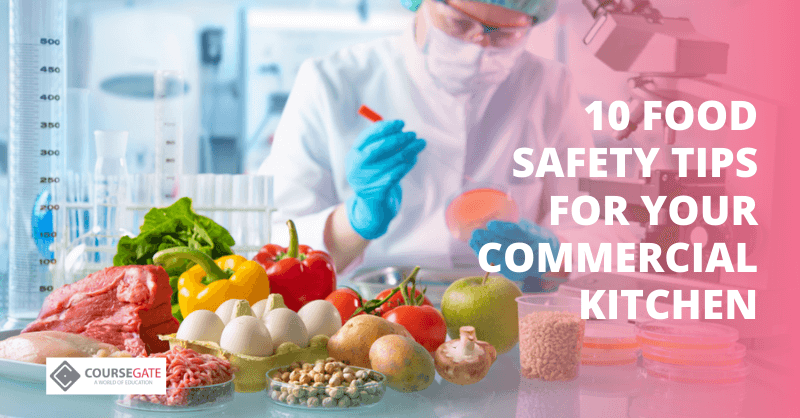

To run a commercial kitchen successfully, you must follow a series of safety tips. You need to guarantee the safety of your employees as well as your customers. It’s also important to take care of the hygiene of your kitchen.
You need to make sure that the places where the food is stored and prepared are clean. This way, you can avoid risks of contamination in your kitchen and save your customers from getting food poisoning. This is your and your staff’s duty.
10 Food Safety Tips for Your Commercial Kitchen
Here are 10 food safety tips for your commercial kitchen.
1. Washing Hands Before Getting Started
This tip might sound like stating the obvious, but it’s the one that counts the most, especially during the covid-19 pandemic. Most of the time, our hands are the carriers of bacteria. So, you nor your employees must touch or cook anything before washing your hands.
During rush hours, the employees in a commercial kitchen might not have enough time to go to the washroom and wash their hands. Hence, you can have a specific hand washing station set up in the kitchen for the ease of your kitchen staff. This ensures the hygiene of workers and prevents the spread of germs or bacteria while preparing food.
2. Perform Monthly Gas Safety Checks on Kitchen Gas Appliances
Many accidents such as explosions occur in kitchens because of gas appliances that haven’t been checked, such as gas stoves and gas cylinders. Gas safety is extremely important in a commercial kitchen.
That’s why you must have yearly, or monthly gas safety checks performed on all gas appliances in your kitchen. A gas safety check cost ranges from £30-£150, depending on the type and number of appliances you use.
It’s also important that you have gas and smoke detectors in your kitchen to prevent any gas leak mishaps and also upgrade kitchen appliances that have become outdated as they can become quite hazardous to use. This way, you’re able to prioritize not only your customers’ safety but also your staff’s safety.
3. Always Check for Expiry Dates on All Ingredients
There have been many cases where people would accidentally use expired ingredients without checking while preparing food. Expired ingredients serve as a breeding ground for bacteria. Using them to prepare dishes can make them carriers of those bacteria, causing food poisoning to your customers. Not only would your restaurant lose customers, but it may face the possibility of being shut down.
Keep that in mind because it’s your responsibility to check the expiry dates and temperatures of the ingredients on the spot when your supply is delivered. If any of the ingredients show any signs of expiry, or if their temperatures are above 40 degrees Fahrenheit, then return the ingredients immediately.
4. Sanitize and Clean your Worktop Stations and Kitchen Equipment Regularly
Many restaurants are shut down because of the unsanitary conditions of the kitchen. When kitchen staff use their worktop stations and other kitchen equipment to prepare food, it’s important that they keep them clean and sanitized after use as well. If it’s not kept clean, they raise more chances of customers getting food poisoning from the food. Of course, this is not something that you alone can do by yourself.
So, inform your kitchen staff to make sure that they clean up themselves after cooking and sanitize the utensils used so that when they use them again, they’re bacteria-free. To make sure that this safety point is obeyed by everyone, health inspectors make frequent visits to check the condition of the kitchen and the restaurant.
5. Provide Your Staff with Proper Food Safety Training
The Food Standards Agency (FSA) created a law to make sure that the above-mentioned safety point is followed by everyone. It ensured that all kitchen staff was provided with proper training in food hygiene and food safety by the restaurant. If this law isn’t obeyed, then the restaurant can be charged with a heavy fine.
Food safety training offers many benefits, such as reducing food wastage and reducing the risks of causing food poisoning. By taking care of the cleanliness and hygiene of the kitchen, staff members also improve their self-hygiene. They also become aware of many food safety risks.
6. Use Gloves
If you don’t have enough time to wash your hands, you can still work in the kitchen with the help of well-sanitized gloves (plastic or rubber). You just have to make sure that you wear a new pair for tasks such as cutting raw meat, marinating the meat, kneading flour, and even when you’re handing food to your customers. This way, you can stop germs from spreading into the food.
Many employees also experience a lot of irritation on their hands while or after dealing with spicy and acidic foods because of how sensitive their skin is. However, by wearing gloves, they can easily prevent that from happening. It is also very common in bakeries for employees to wear plastic gloves when taking pastries and cupcakes out from the display boxes to give to the customers.
7. Rinse Food Ingredients Thoroughly with Water
We all know how important it is to wash and clean our kitchen utensils and other equipment before and after using them. However, you should know that it is just as important to wash the food ingredients before using them as well. Food ingredients such as fruits and vegetables must be washed very carefully, even if their skin is shaved.
Many people think that if they’re not going to eat the skin of the fruit or vegetable, then there’s no need to wash them. This is wrong because if you don’t wash them, then the bacteria that is present on the skin will go inside the fruit or vegetable after you peel or cut off the skin.
There are many diseases that could happen to you if you end up eating unwashed fruits and vegetables. A common example of an illness that can occur is Salmonella, and it spreads from its fecal-oral route that can be transferred to vegetables. Recently tomatoes have been considered the carriers of Salmonella, hence why they should be scrubbed and washed properly with cold water.
8. Avoid Cross-contamination
Cross-contamination can occur when you accidentally spread bacteria from uncooked food to prepared meals. It is spread by using the same utensils or equipment for the prepared foods that you used for raw and uncooked foods such as cutting boards or knives.
It is also spread from raw food contact to cooked food contact, and it can even be spread through your hands after touching raw food. Some examples of raw foods that can spread bacteria are raw meats and poultry, uncooked eggs, and even seafood.
You can avoid cross-contamination by separating your utensils or thoroughly cleaning them after using them on raw foods. You can also separate raw meat from frozen food and cooked food in storage by storing it on the bottom shelf and wrapping it up in a clear and clean plastic foil so that its juices don’t drip on other foods and ingredients. You should do the same for vegetables as well.
9. Monitor Food Storage Refrigeration
When it comes to storing food, you must store them in a place where they don’t go to waste, and their taste doesn’t get affected. They should be kept in a room where the temperature is 40℉ or below it. Frozen food, however, should be kept in freezers where the temperatures are at 0℉ or below.
There is a term called the Danger Zone that is well-known among the kitchen staff. This term is used to refer to the temperatures between 40℉ and 140℉, where harmful bacteria can grow in foods such as raw meat and seafood that need to be refrigerated.
The best way to avoid the Danger Zone is to have the temperatures of the food storage monitored daily. Ensure that temperatures don’t drop or go higher than the original temperatures that they have been set on. It might even be better to set an alarm that can alert you in case this happens.
You should also make sure that you don’t let specific foods that you took out of the refrigerator sit for more than 2 hours. However, if the temperature is above 90℉, then don’t leave food out for more than an hour.
10. Don't Allow Sick Employees to Prepare the Food
If one of your employees has a fever or flu, you should give them a day off or don’t let them cook because they can accidentally infect customers by spreading their germs through the food they prepared.
According to the research conducted by the CDC’s Environmental and Health Sciences, 5% of workers in commercial kitchens have admitted to working while experiencing sicknesses such as diarrhoea, vomiting, and flu.
You're Ready to Make Your Commercial Kitchen Safe
When you go through the above-mentioned points, you will be able to maintain a clean and sanitized commercial kitchen. That prioritizes the safety and well-being of your customers and staff as well as reduces food wastage.
Level 2 Food Hygiene and Safety
Level 2 Food Hygiene and Safety
- All Courses
- IT & Software99
- Microsoft Office64
- Nonprofit & Charity55
- Health & Safety91
- Life Style73
- DIY43
- On Demand Courses42
- Quality Licence Scheme Endorsed113
- Health and Fitness77
- Health and Care162
- Admin42
- Digital Marketing48
- Psychology & Counselling84
- Teaching and Education99
- Design75
- Management129
- Beauty42
- Accounting58
- Employability200
- Human Resource47
- Personal Development131
- Marketing59
- Business153
- Photography38
- Language26













